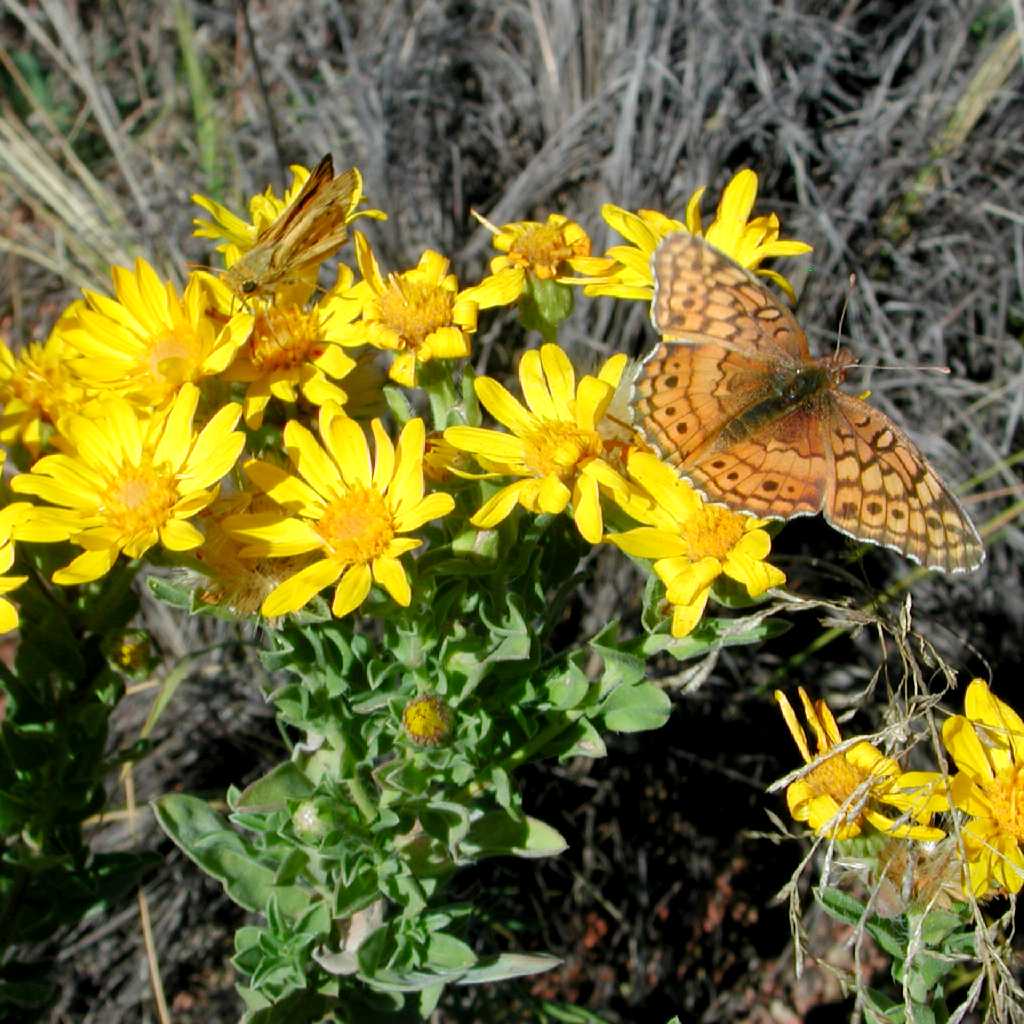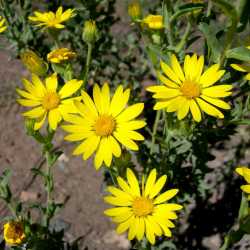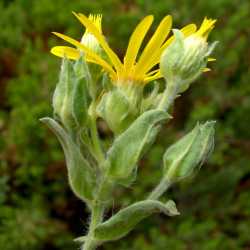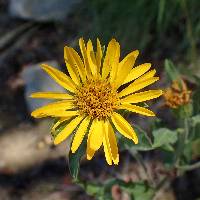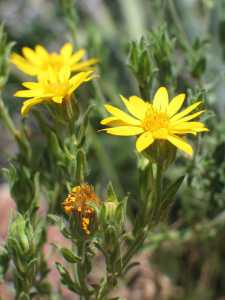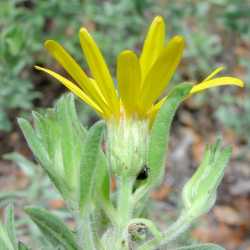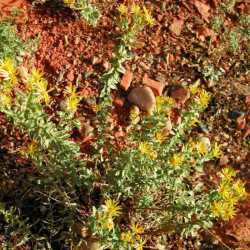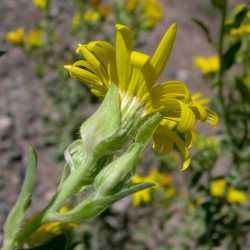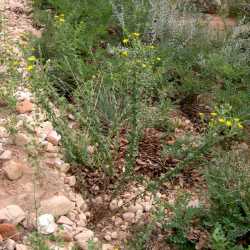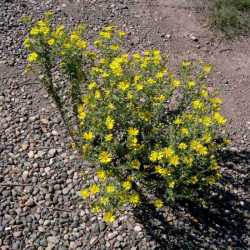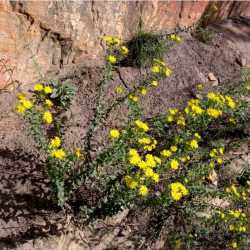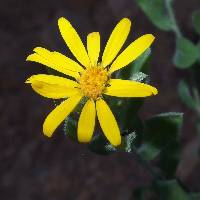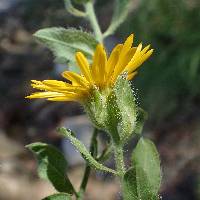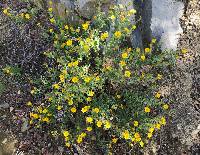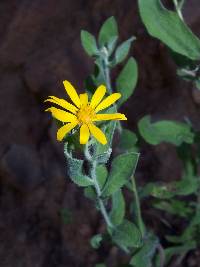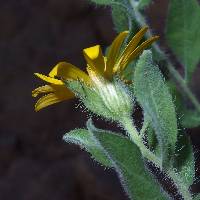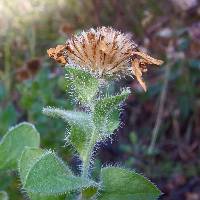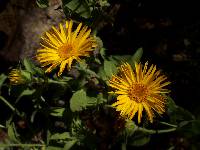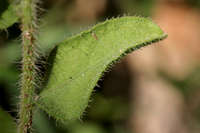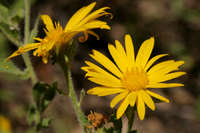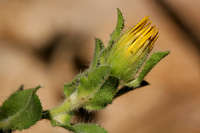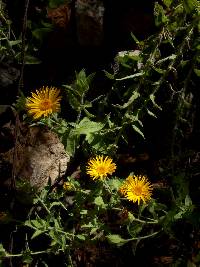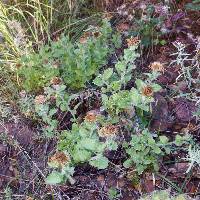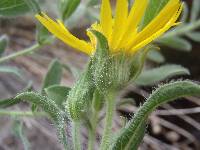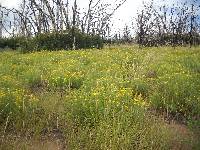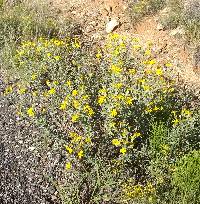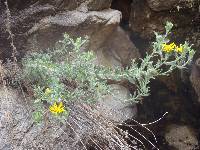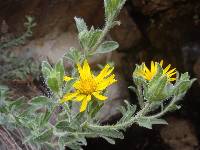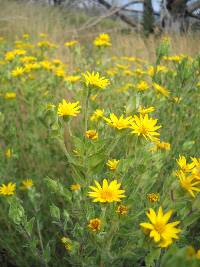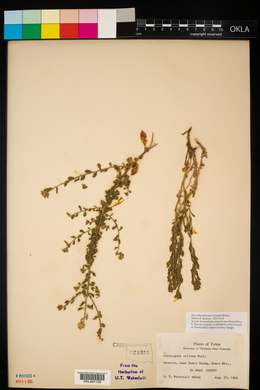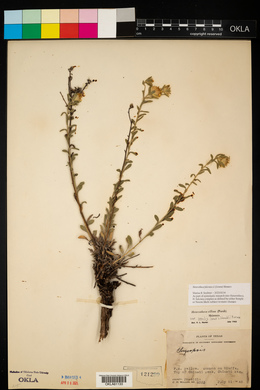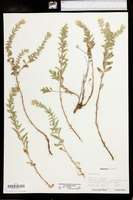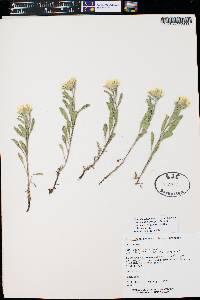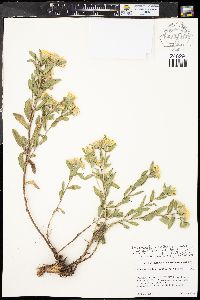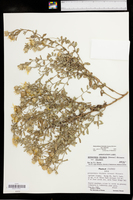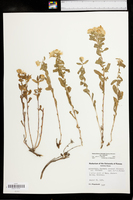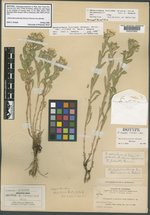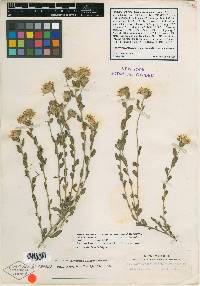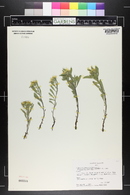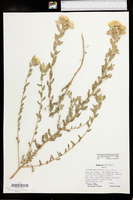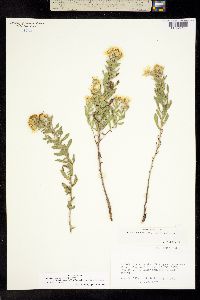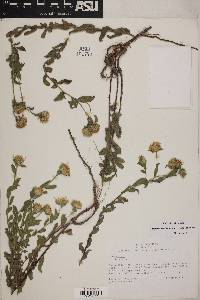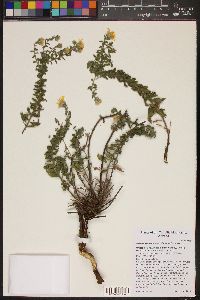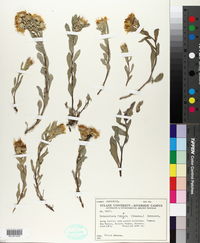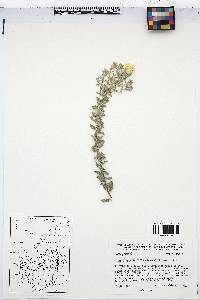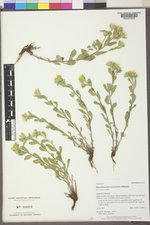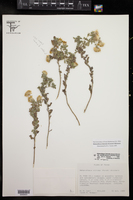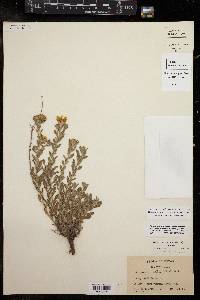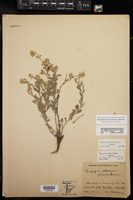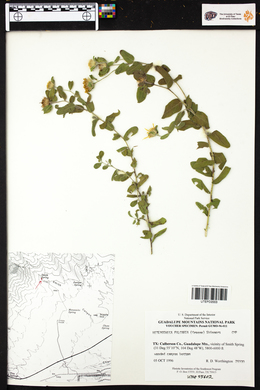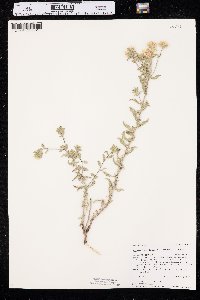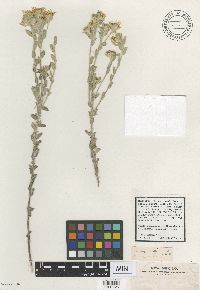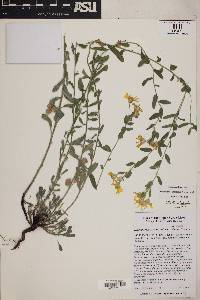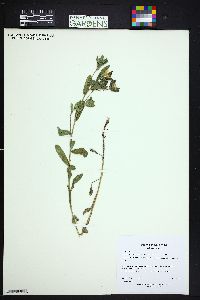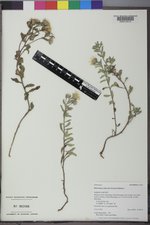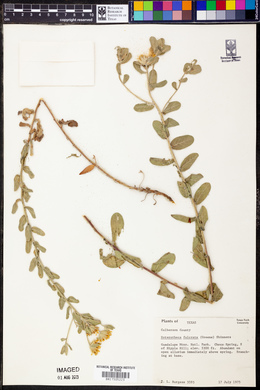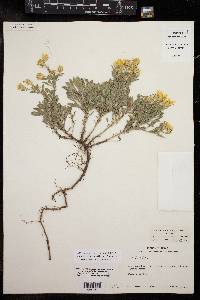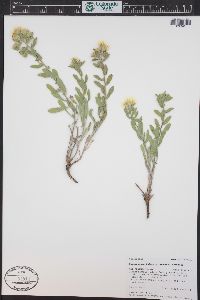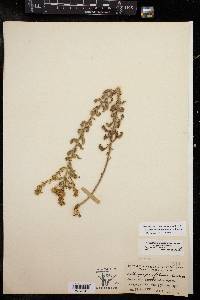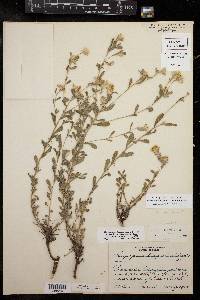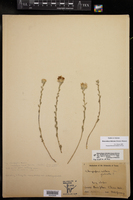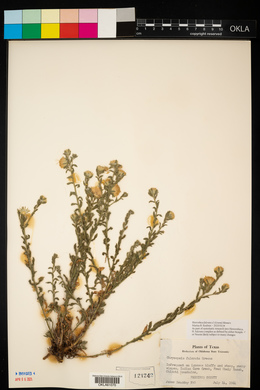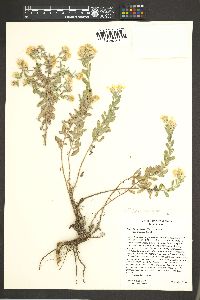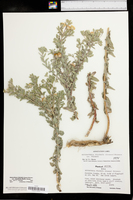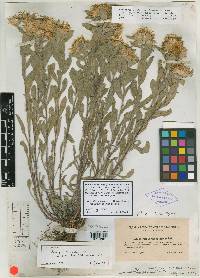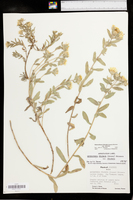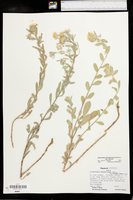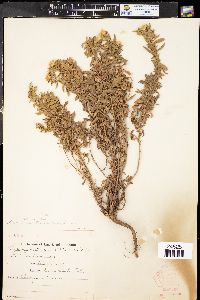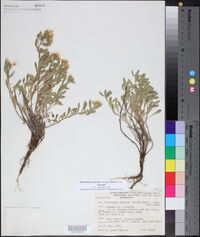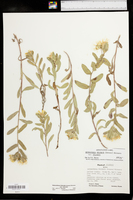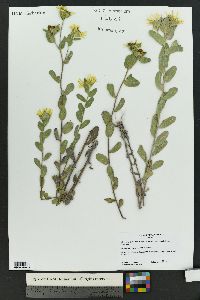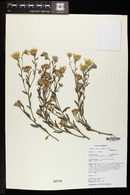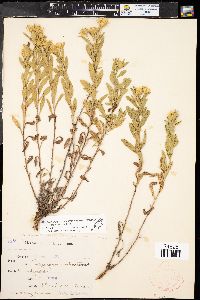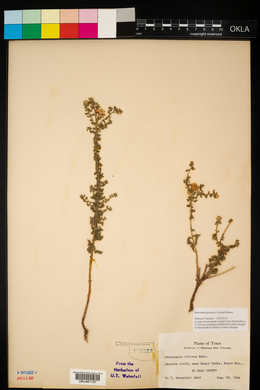
|
|
|
|
Family: Asteraceae
Rocky-Scree False Golden-Aster, more...rockyscree false goldenaster, mountain camphorweed, rockyscree falsegoldenaster
[Heterotheca coahuilensis B. L. Turner] |
Perennials, 17-50(-80) cm; taprooted. Stems 1-30+, ascending to erect (sometimes reddish brown), sparsely to densely hispido-strigose, sparsely to densely stipitate-glandular. Leaves: proximal cauline subpetiolate to sessile, blades oblanceolate, (13-)22-46(-60) × (3.5-)5.3-10(-14) mm, bases attenuate to somewhat rounded, margins entire, strigoso-ciliate (with a few longer hispid cilia near bases), apices mucronate, faces sparsely to densely strigoso-canescent, sparsely to moderately stipitate-glandular; distal sessile, blades ovate to lanceolate, 12-34(-55) × 4-15 mm, little reduced to larger distally, margins entire to somewhat irregularly sinuate, sparsely to densely hispido-strigose (large cilia few to numerous, usually along much of margins, sometimes just proximally), faces sparsely to densely strigose, sparsely to densely stipitate-glandular (sometimes more glandular than more proximal blades). Heads (1-)7-15(-43), in open to compact, corymbiform arrays. Peduncles 1-20 mm, sparsely to densely strigoso-canescent, sparsely to moderately stipitate-glandular; bracts 1-4, proximal ovate to narrowly lanceolate (bases sometimes attenuate and winged short-subpetiolate), leaflike, distalmost often distinct from distal leaves, usually subtending or just proximal to and usually surpassing heads (obscure in narrow-leaved, hairy plants). Involucres cylindric to campanulate, 5.7-9(-10.3) mm. Phyllaries in 4-5 series, lanceolate to linear-lanceolate, unequal (outer lengths 1 / 4 - 1 / 3 inner), scarious, faces sparsely to moderately strigose, sparsely stipitate-glandular. Ray florets (5-)11-21(-34); laminae (7-)9-13(-16) × 1-2.7 mm. Disc florets (12-)26-66(-110); corollas barely ampliate, 5-7.5 mm, glabrate, lobes 0.4-0.9 mm, sparsely hairy (hairs 0.05-0.2(-0.3) mm). Cypselae monomorphic, obconic, compressed, 1.5-3(-4) mm, ribs 10-12 (sometimes golden brown to brown), faces sparsely to moderately strigose; pappi off-white, outer of linear scales 0.25-1 mm, inner of 35-45 bristles (4.3-)5-6.5(-8) mm, longest acute to weakly clavate. 2n = 18, 36 (atypical plants). Heterotheca fulcrata is distinguished by the one to several, usually distinctive, ovate-lanceolate bracts subtending at least some heads of the arrays; the bases of the bracts are attenuate to sometimes winged-subpetiolate. In plants with large, ovate distal leaves, the bracts are sometimes hidden by the leaves. Rarely, such bracts are missing below most heads or only one is present, making identification problematic, but the leaf margins usually harbor large hispido-strigose cilia along much of their length. The density of hairs and glands on leaves, the size and shape of leaves, and the number of florets vary greatly within the species. Four varieties are recognized on the basis of differences in those traits and in the frequency of large hispido-strigose hairs along the leaf margins. All four are sympatric along the Mogollon Rim and in the mountains south of the escarpment, in southeastern Arizona and adjacent New Mexico. Intermediate forms occur throughout the range; pure and mixed varietal populations occur in areas of sympatry. Plants in southern Idaho, northern Nevada, and northern Wyoming are atypical and easily misidentified as aberrant forms of H. villosa.
FNA 2006, Kearney and Peebles 1969, McDougall 1973, Allred and Ivey 2012 Duration: Perennial Nativity: Native Lifeform: Subshrub General: Perennial herbs, to 30 cm tall, from a taproot; stems usually several, spreading or ascending, hirsute and glandular. Leaves: Alternate and sessile along the stems; blades oblong to oblanceolate or elliptic, with mucronate tips and attenuate or rounded bases; blades 2-4 cm long, hirsute or strigose but not canescent, the margins entire to slightly sinuate distally, ciliate. Flowers: Flower heads yellow and radiate, solitary or several at branch tips, and subtended by leafy bracts, the length of the uppermost bract just surpassing the involucre; involucres campanulate to hemispheric, 8-10 mm high, the bracts (phyllaries) in 4-5 graduated series, lanceolate to linear-lanceolate, green with scarious margins, appressed-hirsute and glandular; ray florets 11-35 or more per flower head, yellow, the laminae (ray petals) to 13 mm long; disc flowers 26-100 or more per flower head, yellow. Fruits: Achenes obconic, compressed, strigose, 1.5-3 mm long, with 10-12 ribs; topped with a 2-layered pappus, the outer of linear scales less than 1 mm long, the inner of 35-45 bristles, these 5-7 mm long. Ecology: Found in dry rocky soils, from 5,000-8,000 ft (1524-2438 m); flowers June-October. Distribution: Montana to Texas, New Mexico, and Arizona. Notes: To distinguish H. fulcrata from other Heterotheca spp, look for the leafy bracts subtending at least some of the flower heads, the glandular involucre, and the sessile or very short-petioled leaves. The bracts subtending the flower heads are generally ovate in shape but can be narrower, and are at least as long as the involucres. The herbage and the involucres are covered by both glands and hairs in this species, but the glands can be difficult to see with a hand lens so this may not be the best field character. The leaves are almost all sessile, and occasionally even appear to be partially clasping the stem. Ethnobotany: Unknown, but other species in the genus have uses. Etymology: Heterotheca is from Greek heteros, different, and theke, ovary, referring to the dimorphic achenes of some members in the genus; fulcrata means appendage, for bract or stipule, referring to the distinctive foliose bracts subtending the flower heads. Synonyms: None Editor: LCrumbacher 2011, AHazelton 2017 |
|
|
|
This project was made possible in part by the Institute of Museum and Library Services [MG-70-19-0057-19].
Powered by Symbiota

